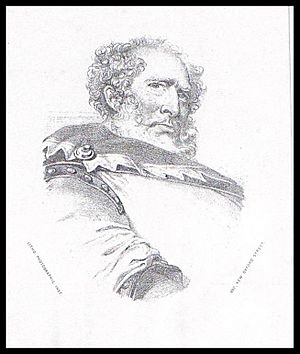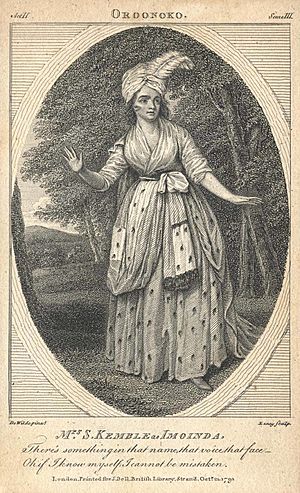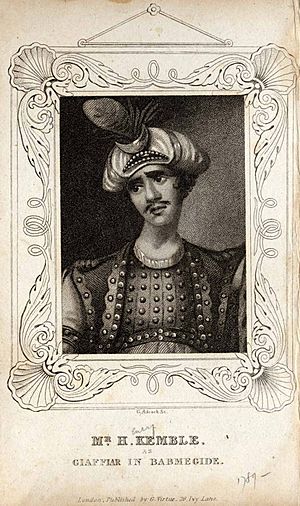Stephen Kemble facts for kids
Quick facts for kids
Stephen Kemble
|
|
|---|---|

Stephen Kemble as Falstaff by James Heath
|
|
| Born |
George Stephen Kemble
21 April 1758 |
| Died | 5 June 1822 (aged 64) |
| Resting place | Chapel of the Nine Altars, Durham Cathedral, England |
| Occupation | Manager, actor, writer |
| Spouse(s) | Elizabeth Satchell |
| Children | Henry Stephen Kemble |
| Parent(s) | Roger Kemble Sarah "Sally" Ward |
| Relatives | Kemble family |
George Stephen Kemble (born April 21, 1758 – died June 5, 1822) was a very successful English theatre manager, actor, and writer. He was part of the famous Kemble family of actors. Many people said he was "the best Sir John Falstaff" the British stage ever saw. He also played important roles like Hamlet and King Lear. Stephen Kemble wrote plays, poems, and other books.
He married the well-known actress Elizabeth Satchell in 1783. His niece was Fanny Kemble, a famous actress and someone who worked to end slavery.
Contents
Stephen Kemble's Early Life
Stephen Kemble was born in Kington, Herefordshire, England. He was one of 13 children! His parents were Roger Kemble and Sarah "Sally" Ward. His brothers and sisters included other famous actors like Charles Kemble, John Philip Kemble, and Sarah Siddons. Stephen and his brothers were raised in their father's Catholic faith. His sisters followed their mother's Protestant faith.
His daughter, Frances Kemble, was a music composer. She was a favorite of the famous writer Sir Walter Scott. She married Captain Robert Arkwright. Stephen's son, Henry, also became an actor.
A Talented Theatre Manager
Like his father, Stephen Kemble became a very successful theatre manager. He ran theatres in England during the 1700s and early 1800s. He managed the first Theatre Royal, Newcastle for 15 years, from 1791 to 1806. He often brought members of his famous acting family and other London actors to Newcastle. His sister, Sarah Siddons, was one of the first big London actors to perform in theatres outside of London. This helped change how people viewed acting in smaller towns.
Stephen Kemble led the Newcastle Theatre through many popular seasons. The people of Newcastle felt very lucky to have such great theatre. The original Theatre Royal opened on January 21, 1788. It was on Mosley Street, near Drury Lane. While in Newcastle upon Tyne, Kemble lived in a large house on Newgate Street.
-
Kemble by John Raphael Smith, National Portrait Gallery

Stephen Kemble also managed other theatres. He ran the Theatre Royal, Edinburgh for a year in 1792-1793. He later managed it for a longer time from 1794 to 1800. He also managed theatres in places like Glasgow, Chester, Lancaster, and Sheffield. From Newcastle, he managed a group of theatres called the Durham circuit. This included theatres in towns like Sunderland, Stockton, and Scarborough. He even built a theatre in Alnwick!
He helped many leading actors of his time become famous. These included his wife Elizabeth Satchell, his sister Elizabeth Whitlock, and Master Betty. He also brought famous London stars to his theatres. Some of these stars were Edmund Kean, Sarah Siddons, and John Philip Kemble.
Stephen Kemble: The Actor
Stephen Kemble was especially famous for playing the character Falstaff. He made his first London appearance with his brother John in 1783. Critics at the time said he found the perfect balance between funny and serious in this role. After his performance in London in 1802, a newspaper wrote that it was a shame he couldn't stay in London permanently. Kemble returned to play Falstaff in London several times and received great praise. After he died, a literary journal wrote that Stephen Kemble was "perhaps the best Sir John Falstaff which the British stage ever saw."
Kemble also played the main characters in plays like Hamlet, King Lear, and Othello. He played Shylock in The Merchant of Venice and many other roles.
John Taylor, a writer for The London Magazine, said Stephen Kemble was a very good actor. Taylor noted that Kemble used his acting to speak out against unfairness. He was especially good at showing honest anger against bad behavior. This was clear when he played the Governor in the opera Inkle and Yarico.
Taylor also wrote that Stephen Kemble was a smart and funny person. He was welcomed into the best social circles in the towns he visited for his acting work.
Stephen Kemble: The Writer
Stephen Kemble also wrote plays. One of his plays was The Northern Inn (1791). It was also known by other names, like The northern lass, or, Days of good Queen Bess. This play was first performed on August 16, 1791, at the Haymarket Theatre in London.
He also published a book of his writings called Odes, Lyrical Ballads and Poems on various occasions (1809). A writer named John Wilson said that Kemble's poems showed strong language and good feelings. He was a pleasant person and a worthy man. Kemble's writings included his thoughts on important events of his time. These included the Battle of Trafalgar, the death of Lord Nelson, and the death of the poet Robert Burns. He also wrote about becoming an abolitionist and supporting the Slave Trade Act 1807, which ended the slave trade.
Stephen also wrote a play with his son Henry Kemble (1789–1836). It was called Flodden Field (1819). This play was based on the Battle of Flodden from 1513. It was performed at the Theatre Royal, Drury Lane in 1818. The play was well-received by the audience.
An essay he wrote, "In the Character of Touchstone, Riding on an Ass," was published in a book called The Actor's Budget (1820).
Later Life and Legacy

After 1806, Kemble moved from Newcastle to Durham and lived in retirement. In his later years, he took on fewer management jobs. He also made only a few appearances on stage.
He was good friends with another famous Durham resident, Józef Boruwłaski. Boruwłaski was a Polish dwarf who was only 3 feet 3 inches tall. People in Durham thought it was an interesting sight to see these two friends, one very small and one very large, walking together.
Kemble's last performance was in Durham in May 1822. He died two weeks later at the age of 64. The people of Durham remembered him fondly. He was honored with a burial in the Chapel of the Nine Altars inside the Durham Cathedral. He and his close friend Józef Boruwłaski were buried next to each other. After Kemble's death, the lively theatre scene in Durham slowed down.
In 2013, some lines from a poem he wrote about a Guinea coin were put on the edge of a £2 coin. The coin was made to celebrate the 350th anniversary of the Guinea coin. The lines read: "What is a Guinea? 'Tis a splendid thing."








